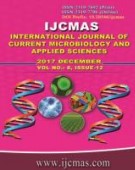


 National Academy of Agricultural Sciences (NAAS)
National Academy of Agricultural Sciences (NAAS)

|
PRINT ISSN : 2319-7692
Online ISSN : 2319-7706 Issues : 12 per year Publisher : Excellent Publishers Email : editorijcmas@gmail.com / submit@ijcmas.com Editor-in-chief: Dr.M.Prakash Index Copernicus ICV 2018: 95.39 NAAS RATING 2020: 5.38 |
A field experiment was conducted in sandy loam soil having slightly alkaline in soil reaction with medium available phosphorous and potassium and low in available N and organic carbon during the Kharif seasons of 2006 and 2007 in factorial randomized block design with three replications to find out the effects of weed management practices and establishment techniques on yield and economics of rice. The result revealed the superiority of the treatment with respect to crop productivity where mechanical hoeing using cono-weeder twice was used as weed management practice which was statistically similar to other weed management treatments like fenoxaprop-p-ethyl (Puma super) @ 0.06 kg a.i ha-1 + 1 HW, metsulfuron methyl + chlorimuron ethyl (Almix) @ 0.00 4 kg a.i ha-1 + 1HW and fenoxaprop-p-ethyl when applied alone whereas the latter two treatments were at par with the treatment metsulfuron methyl + chlorimuron ethyl (Almix) @ 0.004 kg a.i ha-1. Among the establishment methods of rice, statistically non-significant results were obtained with respect to grain yield, straw yield and harvest index in conventional and SRI methods of rice establishment. However, conventional method of rice showed marginally higher yield values over the SRI method of rice establishment. Mechanical hoeing with cono-weeder practised in rice proved to be superior economically as compared to all other weed management practices. Among the rice establishment methods, crop planted under conventional method registered more economic returns as compared to that planted under SRI method. Higher B:C ratio was observed with the mechanical hoeing using conoweeder twice (1.78) which was closely followed by metsulfuron methyl + chlorimuron ethyl (Almix) @ 0.004 kg a.i ha-1 and fenoxaprop-p-ethyl (Puma super) @ 0.06kg a.i ha-1.
 |
 |
 |
 |
 |